Running a successful cannabis store in Alberta takes more than offering high-quality products — it requires a dependable, compliant, and efficient cannabis POS solution tailored to your unique needs.
Our Alberta Cannabis POS Software empowers cannabis retailers to maintain full compliance with AGLC regulations, optimize daily operations, improve customer experience, and scale confidently in Alberta’s competitive cannabis industry.
- Book a Free Demo Now and See How Our Cannabis POS Can Help Your Store Thrive!
The Growing Cannabis Retail Market in Alberta
Alberta’s cannabis industry has emerged as a leading market in Canada, with over 700 licensed cannabis stores operating across urban and rural communities. The province is home to one of the most vibrant and innovative cannabis retail landscapes, serving thousands of customers every day and offering an extensive variety of cannabis products.
With such rapid growth and high consumer demand comes greater operational challenges. Retailers need to ensure they are following stringent AGLC (Alberta Gaming, Liquor and Cannabis) laws while managing large inventories, keeping transactions smooth, and offering exceptional customer service.
That’s where a robust cannabis POS system comes in, providing Alberta retailers with real-time tracking, smart inventory management, and powerful compliance tools to operate with confidence and efficiency.
Key Features of Our Alberta Cannabis POS Software
Our Alberta Cannabis POS Software is not just another generic point of sale solution, it’s purpose-built for cannabis retailers in Alberta. Designed with the specific workflows and regulations of the cannabis industry in mind, it helps dispensaries of any size succeed in this fast-paced market.
1. Compliance-Ready POS Built for Alberta Laws
Staying compliant is non-negotiable in the cannabis industry. Alberta has strict AGLC regulations covering everything from purchase limits and product tracking to age verification and inventory reporting. Our cannabis POS software is fully equipped to keep your operation compliant at all times:
- Real-Time Compliance Reports: Automatically generate up-to-date compliance reports that meet AGLC inspection standards.
- Built-In Regulation Safeguards: Enforce age checks, purchase limits, and product traceability automatically at the point of sale.
- Audit-Ready Records: Every transaction, adjustment, and inventory movement is logged for transparency and regulatory audits.
You no longer have to worry about regulatory headaches, our system helps protect your license and reputation.
2. Smart Inventory Management for Cannabis Products
Managing cannabis products comes with its own set of challenges, from preventing overstock and shortages to meeting demand for trending products. Our cannabis POS includes advanced inventory tools specifically for cannabis retail operations:
- End-to-End Tracking System: Trace products from supplier to shelf to sale with seed-to-sale transparency.
- Automated Restocking Alerts: Receive notifications when stock levels fall below thresholds so you can reorder in time.
- Shelf and Storage Monitoring: Know what’s available, where it’s located, and what needs restocking instantly.
This saves time, reduces manual errors, and ensures your customers always find the products they’re looking for.
3. Real-Time Tracking and Advanced Reporting
In a competitive market like Alberta’s, having access to real-time data can give your cannabis store the edge. Our software delivers powerful insights and up-to-the-minute visibility:
- Live Dashboards: Monitor sales trends, product performance, and customer patterns at a glance.
- Regulatory Transparency: Integrated tracking keeps you aligned with compliance reporting.
- Customizable Analytics: Dive into data that matters most from hourly sales peaks to inventory turnover rates.
4. Optimized for the Cannabis Industry
Many POS systems on the market are simply adapted from other industries, but ours is designed from the ground up for the cannabis sector:
- Built specifically for the unique workflows of cannabis retailers.
- Supports both high-volume dispensaries and boutique cannabis stores.
- Flexible enough to adapt as your operation scales, whether you expand locations or introduce delivery services.
By choosing a solution made for your industry, you avoid the inefficiencies of a one-size-fits-all system.
5. User-Friendly Experience for Staff and Customers
Your team shouldn’t have to wrestle with complicated software. Our cannabis POS was created to be intuitive and easy for anyone to use:
- Fast Setup: Deploy the system quickly with step-by-step onboarding.
- Intuitive Checkout Workflows: Reduce wait times and improve customer satisfaction with efficient transactions.
- Continuous Support: Our expert team is available to answer questions and keep your system running smoothly.
Why Choose Us
On top of the robust features above, our Alberta Cannabis POS Software delivers additional advantages:
- Integration with Existing Systems: Connect your POS to your website, cannabis delivery software, accounting tools, and more for seamless operations.
- Enhanced Customer Experience: Serve customers faster and track loyalty with built-in CRM features.
- Scalable for Growth: Whether you’re managing one store or planning to open more, our POS grows with your business.
- Built-In Security: Protect sensitive customer and business data with advanced security measures.
We understand the needs of Alberta cannabis retailers and have designed our system to deliver unmatched performance and peace of mind.
Why Cannabis Retailers Across Alberta Trust Us
Alberta cannabis retailers face a unique set of challenges and our software is designed to meet them head-on. Here’s why so many local dispensaries choose our cannabis POS over the competition:
- Local Expertise: We understand Alberta’s AGLC compliance landscape inside and out.
- Tailored for Cannabis: Not a repurposed retail POS this is software built specifically for cannabis products and regulations.
- Superior Support: Get personalized guidance and technical support from a team that knows your business.
- Future-Ready: As regulations and consumer demands evolve, our system evolves with you, ensuring you’re always a step ahead.
For cannabis retailers in Alberta, our POS isn’t just software it’s a strategic partner in your success.
Ready to Elevate Your Cannabis Store?
Take your cannabis retail operation to the next level with our Alberta Cannabis POS Software, designed to keep you compliant, efficient, and growing.
- Schedule Your Free Demo Today and See How Our Software Can Power Your Success!
We’re here to help your dispensary thrive in Alberta’s competitive and exciting cannabis industry.
Explore More Cannabis Retail Solutions
Looking for more ways to enhance your cannabis retail business? Discover our full range of Cannabis POS solutions including delivery software and other tools designed to help cannabis retailers streamline operations and delight customers.





















